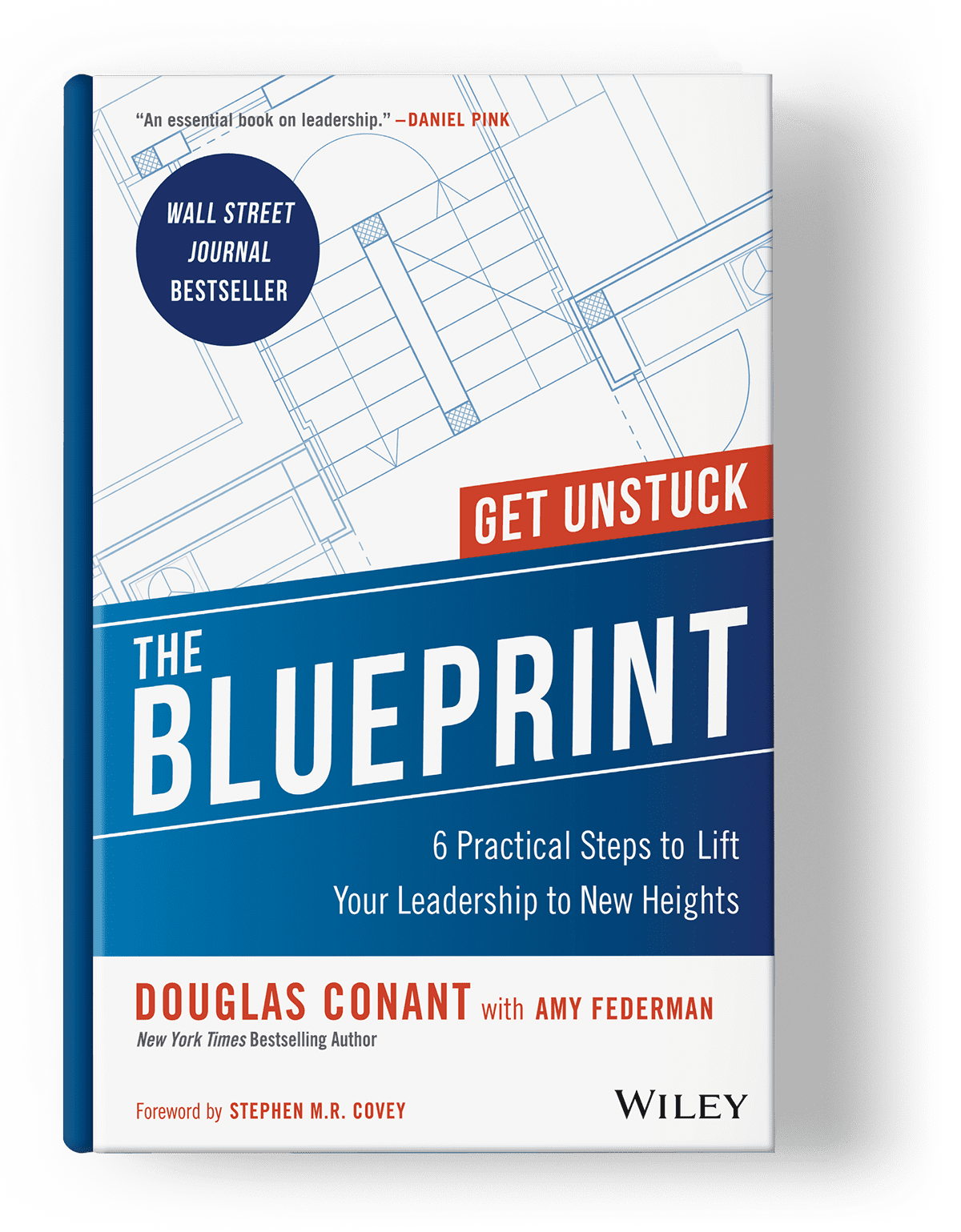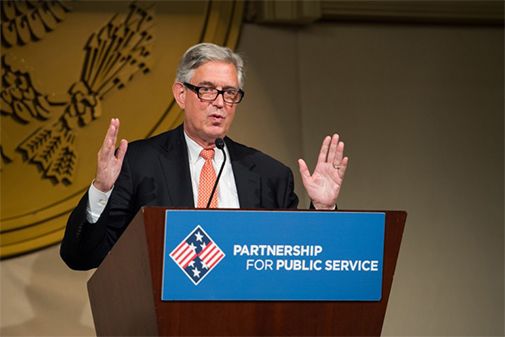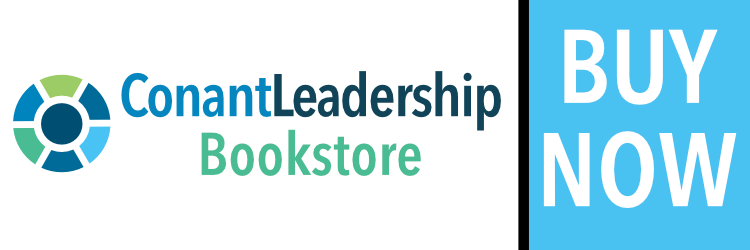25 Specific, High-Impact Practices for Leaders
Leadership is the art and science of influencing others in a specific direction. One of the most powerful ways to lead effectively and authentically over time is to develop your own personal leadership model. A leadership model is an organized approach to expressing how you want to lead in a way that is true to who you are; a model accounts for your purpose, your core beliefs, your goals, your personal story, and your unique temperament and skill-set. (To give you an example, the ConantLeadership Flywheel is our Founder, Doug Conant‘s leadership model).
Practices transform the ideal into the real.
Ideally, a leadership model is an elegant representation of how you will lead in a way that honors both your competence and your character; at its best, it can empower you to deliver enduring high performance for all stakeholders.
At the ConantLeadership Boot Camp (our transformational leadership development program) we guide leaders through our custom process for creating their very own leadership model. Then, we ask them to cultivate practices to bring that model to life. That’s where it gets really exciting. A lot of the work we do in our leadership development can seem intangible. There is a lot of thinking, ideation, reflection, and philosophizing — which is all necessary. You must dig deep to identify what your ideal leadership approach will look like. But it’s practices that transform all the idealism of driven leaders into the realism that makes an impact in actual leadership moments. In leadership, practices are what really make the difference; they transform thoughts into action.
To mobilize you to go forth and make a bigger difference in your organization, we’ve compiled some of the most effective high-impact practices that Boot Camp participants have cultivated and shared with us over the past year or so as they’ve created their models. We omitted names to protect privacy, but these are real, specific practices used by some of the top leaders in their field from world-class companies all over the globe. Hopefully, you will find something actionable below that helps you show up more meaningfully in your leadership. Explore the practices below and then share your own top practices in the comments.
1. “Be gracious with time and praise. Say thank you more often. And when I have a lot of follow-up questions, explain that I’m asking out of curiosity to ensure I fully understand how they got there, not to be critical.”
Connect with people on their turf.
2. “Knowing I have a tendency to interrupt and/or take over meetings, I have developed a Listening Better spreadsheet that I keep on my desk and bring to meetings. I record each time I have the urge to interrupt, take over a meeting, or get distracted — from either an email, IM, telephone call or simply looking at my computer instead of staying focused on the interaction. As I mark myself, I share the concept with the person/people I am meeting with as a form of transparency.”
3. “To get more commitment, get people more involved. Take the schedule and deadlines offline so they’re all on a highly visible board with people’s names and tasks. Find a way to recognize and celebrate people who got everything out on time and create a framework for assigning people to help each other.”
4. “Do weekly walk-and-talks with 3 or 4 key influencers in my group.”
5. “Encourage collaboration and parse out time at weekly team meeting for individuals to bring up problems they’re tackling. This encourages problem-solving from other team members so they don’t feel isolated on an ‘island.’”
6. “Listen better. Be more present in conversations. During meetings, I ask people to turn off phones and take notes with pen. I model the behavior by starting the meeting by turning off my devices to get the ball rolling and set the expectation.”
7. “When you have a meeting, go to their office or desk. Don’t just always have them come to you. Connect with people on their turf.”
8. “Sit down and spend informal time with each direct report. No multi-tasking or looking at devices. Practice being fully present for everyone in the room. Make sure that I’m properly connecting with people, especially outside the office. Informal opportunities for connection can include golfing or lunch on a more regular basis.”
9. “For better communication and transparency, I do ‘5-bullet Fridays’ – a weekly email that reports to my organization 5 things I want everyone to hear. Might be anything from expressions of gratitude to performance updates to welcoming new team members.”
10. “Make sure to provide ‘change updates’ during times of volatility and change. Add a ‘change’ element to the weekly staff meetings. Also add a quote to these meetings from authors, musicians, etc.”
11. “For increased accountability and engagement, be more inclusive with prioritization and tradeoff discussions. Don’t be the only ‘decider.’”
12. “Create a monthly newsletter that goes out to our team that focuses on what is working but also highlights what’s not working to open up a problem-solving forum to address issues and challenges. Gives people the opportunity to be recognized as problem-solvers.”
13. “Send in questions beforehand for regularly scheduled weekly or bi-weekly check-ins.”
14. “I’m working with a new team. To add transparency to this new initiative, will have a bi-weekly news brief arranged by the 5 goals we’ve set for our team. Scorecard will report against those goals—what’s working, what’s not. Potentially include video where leaders are interviewed about why key goals are important to them.”
Be gracious with time and praise.
15. “At end of monthly metrics report, add emails from customers to celebrate their recognition and ‘thank yous’ in a way that gives them visibility to senior management.”
16. “Working to alter the cadence/format of interaction in meetings. Idea is to change it from me always leading it, to empowering other team members to lead it, with me asking what I can do to help. Put the expectation on them to tell me where I should be focusing my attention. This will force me to be quieter, let other people talk, and listen more. Engineer a situation in which I’m asking reports to set my agenda for me for the month.”
17. “End conversations with, ‘How can I support you?’’”
18. “I’m involved in a lot of cross-functional projects. With some of the more strategic projects, bring a team member along to give them more exposure to other parts of the organization, and give them the opportunity to participate in leading some of these meetings. I give updates to the VP of our group; I can empower other team members to give presentations on different facets to build their skills and develop them.”
19.” To strive for excellence, provide real-time feedback. Ensure timely course correcting and learning.”
20. “Take the time to recognize individual efforts by various members of our virtual team with a personal note. While not a daily occurrence, it will be helpful for me to let team members know that I appreciate their significant efforts. I ordered and received personal stationery last week.”
21. “Be very intentional to ‘make nice happen.’ Gift someone their favorite candy bar or tea.”
22. “We are in one of our most stressful times of the year. On Monday, I took it upon myself to roll up my sleeves and take on some of the “grunt” work. I think I caught people off-guard because my behavior was not the norm. I was appreciated for stepping in to assist but at the same time some were concerned my helping meant I wasn’t happy with their performance. To clarify, I made sure to express how great the project was going and that I only wanted to contribute to allow them more time for friends and family and to help eliminate those long hours of work.”
23. “Have coffee around the ‘scorecard’ once a week to discuss what’s going on. During this discussion, celebrate what has been accomplished and identify what needs attention.”
24. “I am very impatient and historically get directly to business. To get better, I am consciously adding, ‘Hi _____ how are you doing today, do you have a moment to discuss something.’ I am utilizing this both in person and on the telephone. It is slowly becoming easier to incorporate into my touchpoints and I will continue this practice as it does in fact change the tone of the engagement from both sides.”
25. “Me and the other attendees from my company have established a re-occurring meeting to build off the program and ‘hold each other accountable’ to living our purpose and leadership core beliefs. So far everything is positive; I have new motivation and direction to energize myself to bring additional leadership to my organization.”
**For more on practices, explore our post on the 5 traits of an effective leadership H.A.B.I.T, our post on how to listen like a leader, our treatise on how to choose goals that motivate your team, and discover our 10 powerful ways to give thanks with your leadership.
 Interested in creating your own leadership model and suite of high-impact practices? Join ConantLeadership at one of our upcoming boot camps in Philadelphia, PA. Taught personally by our Founder and Fortune 300 CEO, Doug Conant, our 2-day in-person program kicks off a life-changing year of additional coaching and mentorship. This is an exclusive opportunity and space is limited. Apply today.
Interested in creating your own leadership model and suite of high-impact practices? Join ConantLeadership at one of our upcoming boot camps in Philadelphia, PA. Taught personally by our Founder and Fortune 300 CEO, Doug Conant, our 2-day in-person program kicks off a life-changing year of additional coaching and mentorship. This is an exclusive opportunity and space is limited. Apply today.
(Photo by rawpixel.com on Unsplash)

“Doug Conant is remarkable—and so is this work.“
– Stephen M. R. Covey
Author of The Speed of Trust

The Blueprint
6 Practical Steps to Lift Your Leadership to New Heights
By Douglas Conant with Amy Federman

Have Doug Speak at Your Event
Doug works collaboratively with event organizers to customize his material for each audience.




0 Comments